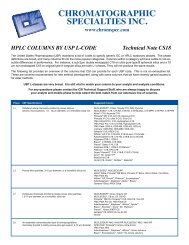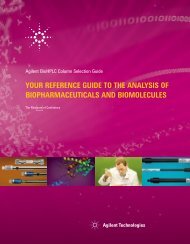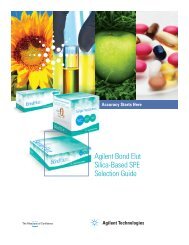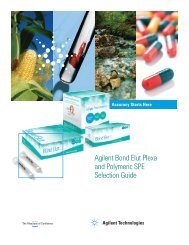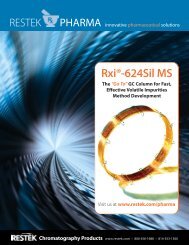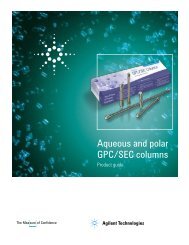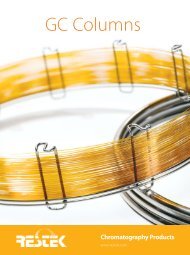Optimizing the Analysis of Volatile Organic Compounds
Optimizing the Analysis of Volatile Organic Compounds
Optimizing the Analysis of Volatile Organic Compounds
You also want an ePaper? Increase the reach of your titles
YUMPU automatically turns print PDFs into web optimized ePapers that Google loves.
Step 5. Desorb<br />
Once <strong>the</strong> desorb preheat temperature is reached, <strong>the</strong> purge and trap unit valve is rotated. This<br />
directs <strong>the</strong> desorb (carrier) gas flow to backflush <strong>the</strong> adsorbent trap and carry <strong>the</strong> analytes in<br />
a narrow band to <strong>the</strong> GC system. Figure 4 (page 7) shows <strong>the</strong> flow path <strong>of</strong> <strong>the</strong> desorb mode.<br />
While <strong>the</strong> sample transfer occurs, <strong>the</strong> trap is heated to its final desorb temperature. Desorb<br />
temperatures range from 180°C-250°C, determined by <strong>the</strong> adsorbent materials and <strong>the</strong> model<br />
<strong>of</strong> concentrator. The desorb flow rate is extremely important; it must be high enough to<br />
ensure that <strong>the</strong> sample remains in a narrow band during <strong>the</strong> transfer to <strong>the</strong> GC column. The<br />
optimum desorb flow rate for a purge and trap system is >20mL/min.; however, this flow<br />
rate is too high to use with capillary columns and must be reduced to retain column efficiency.<br />
The optimum flow rate for 0.53mm ID columns is 8-10mL/min. For narrow bore capillary<br />
columns (0.18-0.32mm ID), <strong>the</strong> desorb flow rate usually is 1-2mL/min. when direct<br />
interface is used. This low flow rate requires a longer desorb time due to <strong>the</strong> slow transfer <strong>of</strong><br />
<strong>the</strong> sample from <strong>the</strong> trap, which, in turn, creates a wide sample bandwidth resulting in broad<br />
peak shapes for all early eluting compounds. Cry<strong>of</strong>ocusing (i.e., cold trapping) can be used<br />
to reduce band broadening, by installing a secondary cold trap or by cooling <strong>the</strong> GC column<br />
to subambient temperatures. The desorb time is inversely proportional to flow rate and trap<br />
temperature, so that as <strong>the</strong> flow rate/trap temperature increases, <strong>the</strong> desorb time decreases,<br />
due to <strong>the</strong> analytes flushing <strong>of</strong>f <strong>the</strong> trap at a higher rate. Also, it is possible to desorb at higher<br />
flow rates (25-80mL/min.), when using narrow bore capillary columns, by using a split<br />
injector to split <strong>the</strong> flow prior to <strong>the</strong> column (for more details on this technique see <strong>the</strong> GC<br />
System Configurations section, page 18).<br />
Step 6. Trap Bake<br />
After <strong>the</strong> desorb step <strong>the</strong> trap is baked, with gas flow, to remove any remaining sample components<br />
and contaminants from <strong>the</strong> trap in preparation for its next use. This step generally<br />
lasts 6-10 minutes; typical temperatures are 10-20°C above <strong>the</strong> desorb temperature. To prevent<br />
damage to <strong>the</strong> adsorbent materials, do not exceed <strong>the</strong> maximum temperature <strong>of</strong> <strong>the</strong> trap.<br />
Purge and Trap Components<br />
Purge Vessel<br />
Three types <strong>of</strong> purge vessels (i.e., spargers) commonly are used in purge and trap systems.<br />
Frit spargers (Figure 5) are used for most water samples. The frit creates many small bubbles<br />
that travel through <strong>the</strong> sample to increase purging efficiency. Fritless spargers are used for<br />
samples that have high particulate content, or for industrial wastewater samples that may<br />
foam. They create fewer bubbles, which decreases purging efficiency but eliminates plugged<br />
frits and reduces foaming problems. Needle spargers are used when purging soil, sludge or<br />
solid samples. A narrow gauge needle is inserted into <strong>the</strong> sample and used to release a small<br />
stream <strong>of</strong> purge gas. The two common sizes <strong>of</strong> spargers are 5mL and 25mL.<br />
Figure 5.<br />
Purge and trap frit spargers.<br />
For Tekmar 2000, 3000, or 3100.<br />
Available in 5mL and 25mL sizes.<br />
Uniform frits ensure maximum purge efficiency for<br />
water samples.<br />
Manufactured to tight tolerances to ensure a leak-free seal.<br />
Description qty. cat.#<br />
5mL Fritted Sparger,<br />
Not recommended for wastewater samples because <strong>the</strong> sample might<br />
foam or <strong>the</strong> frit might become plugged.<br />
1 /2-inch mount ea. 21150<br />
25mL Fritted Sparger, 1 /2-inch mount ea. 21151<br />
Step 5.<br />
Desorb<br />
Analytes are backflushed<br />
into column.<br />
Typical time: 2-4 min.<br />
Typical temp.: 180°-250°C.<br />
Typical flow: 10-80mL/min.<br />
Step 6.<br />
Trap Bake<br />
Trap is baked clean with flow.<br />
Typical time: 6-10 min.<br />
Typical temp.: 10-20°C<br />
higher than desorb temp.<br />
Avoid overheating adsorbents.<br />
www.restekcorp.com<br />
9





